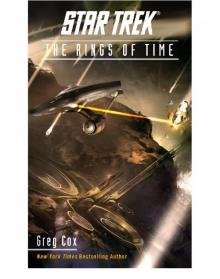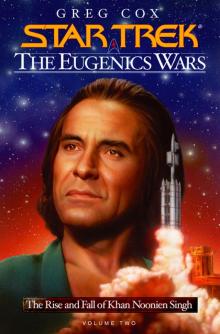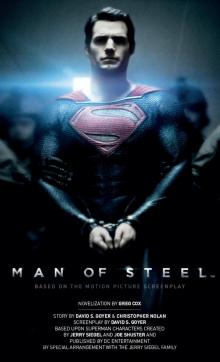Child of Two Worlds (Star Trek: The Original Series) Read online
Page 3
He regarded the wounded ship on the viewer. The closer it got, even more damage caught Pike’s eye. Cracks threatened the structural integrity of the Ilion’s tinted forward viewing port. Sparks sprayed from the laboring nacelles, flaring brightly before being snuffed out by the vacuum. Charred bits of plating went flying off into space, along with clouds of ash and smoke. It became harder to tell if the ship’s erratic course was an evasive maneuver or simply a loss of navigational control. Ilion’s shields were shredding faster than solar sails in an ion storm. From the looks of things, the Enterprise had arrived just in time.
But to do what?
“The Klingon vessel is coming into view,” Spock reported, peering into the gooseneck monitor at his station. “It appears to be a D-5 battle cruiser.”
An image on the viewer confirmed Spock’s readings. Pike’s jaw tightened at the daunting sight of the immense vessel chasing after the Ilion. Its bulbous command pod thrust aggressively ahead of its massive engineering hull, which consisted of two downward-pointing wings. A deceptively fragile-looking neck connected the prow of the ship to the aft section, while Pike’s gaze was drawn to the disruptor cannons tucked beneath its wings and the photon torpedo launcher mounted in the bottom half of the command hull, below the bridge. The battle cruiser was a formidable warship, comparable in size and strength to the Enterprise, at least according to Starfleet Intelligence. Pike was in no hurry to test the accuracy of that assessment.
“Raise shields,” he ordered. “Full strength.”
Unlike the Enterprise, the Ilion was clearly no match for the battle cruiser. Pike was impressed that it was still in one piece. Granted, it was keeping one step ahead of the Klingons now, relying on its speed and evasiveness to stay intact, but the battle cruiser had enough firepower to blast it to atoms with just one shot. How had it managed to last this long?
“Interesting,” Spock observed, as though wondering the same thing. “The Klingons appear intent on capturing the Ilion rather than destroying it.”
Disruptor fire, bright as emeralds against the darkness of the void, sprayed from the battle cruiser’s weapons ports. Bolts of destructive energy passed above and around the Ilion, missing the endangered vessel by mere kilometers. A close call, Pike noted, but maybe not as close as one might expect? The Klingons were a warrior race. They weren’t known for sloppy marksmanship.
Warning shots? From Klingons?
“Hail the Klingon vessel!” Pike ordered. “Find out what’s going on here!”
“Aye, sir!” Garrison replied, even as the tense situation played out on the viewscreen before Pike’s eyes. The Ilion had apparently led the Klingons on a merry chase, but it was obviously on its last legs. Its tattered shields looked flimsier than an Orion dancing girl’s veils. They flickered erratically.
“Captain,” Spock said sharply. “Sensors indicate that the Ilion is in extreme distress. Its shields are buckling, its structural integrity is severely compromised, life-support is failing, and their overtaxed warp engine is approaching a catastrophic breach.” He kept his gaze glued to the readouts on his monitor. “I suspect that the ship’s pilot has exceeded all recommended safety parameters . . . with dire but predictable results.”
Pike got the picture. “They pushed Ilion too hard for too long, trying to get away from the Klingons, and now the ship’s coming apart.”
“Precisely, Captain,” Spock said. “Add that to the damage already inflicted on the ship by the Klingons, and Ilion’s destruction is a near certainty. Only minutes remain to it.”
So much for being captured instead of destroyed, Pike thought. It was as though whoever was flying Iion would rather die than be taken alive.
“The Klingons have responded, sir,” Garrison said. “They’re warning us not to interfere.”
“And?” Pike prompted.
“That’s it, sir. They’re telling us to mind our own business . . . or else.”
Now, that sounds like the Klingons, Pike thought. He didn’t doubt that Garrison was accurately conveying the gist of the communication. So now what I am supposed to do?
“I am detecting two life-forms aboard the Ilion,” Spock added. “Humanoid, and growing weaker.”
“Cyprian?” Pike asked, recalling the ship’s alleged origin.
“Possibly,” Spock replied, “but Ilion’s engine is approaching critical. It will explode in approximately four minutes, possibly sooner.”
“Chris,” Boyce said urgently, standing anxiously beside the captain’s chair. “We can’t let them die.”
“And we’re not going to,” Pike said, reaching a decision. He stabbed the intercom button on his armrest. “Captain to transporter room. Lock onto both life signs aboard the Cyprian vessel and beam them aboard . . . quickly, before it’s too late.”
Transporter Chief Pitcairn’s gruff voice replied at once. “Yes, sir.”
“Lower shields, Mister Tyler,” Pike ordered. “Just long enough to beam any survivors aboard.”
Spock turned away from his monitor. “Is that wise, Captain? The Klingons—”
“Will hopefully think twice before firing upon a Starfleet vessel,” Pike said. “At least long enough for us to transport Ilion’s crew and passengers to safety.”
It was a gamble, but Pike didn’t see any choice. They couldn’t beam anyone aboard without lowering their shields, and those people aboard the Ilion were doomed if they didn’t try. With any luck, the Enterprise wasn’t yet within firing range of the oncoming battle cruiser, but it was hard to tell with any degree of certainty. Even a century-plus after Broken Bow, there was still a lot Starfleet didn’t know about the Klingons and their capacities.
“The Klingons are still ordering us to back off,” Garrison said. “And they don’t sound happy.”
So what else is new, Pike thought. “Tell them we’re on a mission of mercy.”
“Not sure ‘mercy’ is in their vocabulary,” Tyler said. “I hear the Klingons don’t take prisoners.”
“And yet they seem determined to capture Ilion and its passengers.” Spock arched an eyebrow. “Curious.”
My thoughts exactly, Pike reflected. More than ever, he wanted to know whose lives they were trying to save—and why the Klingons apparently wanted them alive.
“Spock, get down to the transporter room, on the double.” Pike wanted to head there himself, to find out whom exactly they were beaming aboard, but he could hardly leave the bridge while they were staring down a Klingon battle cruiser. With Number One away, Spock was currently second-in-command aboard the ship, so Pike delegated the job to him. “Doctor, you had better join him. You may be needed.”
“Try and stop me,” Boyce said. Medkit in hand, he hurried toward the turbolift. “Come on, Spock. Time’s a-wasting.”
“You need not remind me, Doctor.” Spock turned the science station over to Ensign Weisz, a short, wiry youth with curly black hair and, according to Spock, a notable aptitude for computers—for a human, that was. Spock moved briskly, intercepting Boyce at the rear of the bridge. “I’m quite aware of the urgency.”
The turbolift had barely departed, taking the two men with it, when the Ilion died a fiery death on-screen. A blinding flash lit up the viewer as the Ilion’s overheated engine gave way. Pike blinked and raised a hand to shield his eyes from the glare before the screen automatically dimmed the image to compensate. A shock wave from the explosion rattled the bridge. Yeoman Colt, who had been approaching the command well with the latest round of status reports, gasped and grabbed on to the safety rail to keep her balance. Her data slate clattered onto the hard metal deck.
“Sorry, Captain,” she blurted. “That was quite a bump.”
Pike barely noticed the slim young redhead’s stumble. Leaning forward in his chair, gripping the armrests, he peered intently at the screen. Blue spots danced before his vision, but he could make out the Ilion’s fate easily enough. Nothing remained of the ill-fated Cyprian vessel but a cloud of plasma and particulate debris. The sh
ip had been all but vaporized.
But what about her passengers?
He hit the intercom again. “Transporter room! Did you get them?”
* * *
A shock wave rocked the turbolift. Clearly, Spock deduced, the Ilion was no more.
Rushing into the transporter room alongside Boyce, he was surprised to find the transporter platform empty. Although he and Boyce had wasted no time arriving there, he had still expected to find the survivors of the Ilion already beamed aboard, provided that Chief Pitcairn and his assistant had managed to lock onto the endangered individuals in time.
He quickly surveyed the situation. Pitcairn, a beefy Earthman with closely cropped brown hair, was manning the primary control console, while to his right, Technician Sam Yamata operated the auxiliary controls. Transporting individuals in the form of energy patterns was not a task to be taken lightly; currently Starfleet protocols built a certain degree of redundancy into the process for safety’s sake. No one desired a replay of the tragic DeLambre incident. One such disaster was enough.
Both men were clearly struggling at the controls. Beads of perspiration dotted Pitcairn’s furrowed brow. Yamata peered intently at his sensor readings through a pair of archaic black-rimmed glasses. Spock recalled that the man possessed a significant allergy to Retinax and other conventional treatments for myopia. Both men looked as taut as the strings on a Vulcan lyre.
“What’s the matter?” Boyce asked anxiously, clutching his medkit. “Why haven’t you beamed them aboard yet?”
“The Klingons have locked onto them too,” Pitcairn said, never looking away from his controls. His big hands worked the levers with remarkable deftness. “We’ve got a tug-of-war going on here.”
Spock instantly grasped the severity of the situation. The targeted individuals could not long exist in an energized state before their patterns were irrevocably degraded. He briefly considered ceding the Ilion’s survivors to the Klingons, if only to save them from being lost forever, but was reluctant to do so before making every effort to bring them aboard the Enterprise instead. He doubted that he would be doing the survivors any favors by letting the Klingons “rescue” them. Indeed, the unknown individuals might well prefer to have their atoms painlessly dispersed into space compared to what they could expect at the brutal hands of the Empire.
“What is your honest assessment, Transporter Chief?” Spock asked. “Can you successfully wrest the patterns from the Klingons?”
“I’m giving it my best shot,” Pitcairn said. “We locked onto the subjects first, and were closer to the Cyprian ship to boot, but the Klingons are working overtime to hijack the matter stream from us. It’s all we can do to keep the patterns intact without losing them.”
Yamata squinted at his readings. “The scanners are still picking up two distinct patterns, but they’re practically suspended between us and the Klingons.” Worry tinged his voice. “I’ve never known a transport to take this long before . . .”
“Allow me, Technician.” Spock crossed to the room to the control podium, choosing to deal directly with the crisis. “I believe I can be of assistance here.”
Yamata stepped aside, surrendering the console to Spock without protest. If anything, he looked relieved and grateful for Spock’s intervention, although the technician’s feelings were the least of Spock’s concerns at the moment. A rapid inspection of the scanner readings confirmed that both the matter streams were in danger of being torn apart by the conflicting forces being exerted on them. In a worst-case scenario, it was entirely possible—and growing increasingly probable—that the streams would be split between the two ships, so that each transporter station received only a portion of the individuals in transit.
“Divert power from engineering to the annular confinement beams,” Spock instructed Pitcairn while recalibrating the quantum resolution protocols. A recent treatise from the Vulcan Science Academy, regarding oppositional wave form functions and their practical application with respect to phased subatomic decoupling, suggested an innovative approach that might yield positive results in this instance. “I am attempting to enhance our lock on the patterns . . . and disrupt the Klingons’ hold on the subjects.”
The trick was to bring the confinement beam into synch with the quantum wave amplitude of the phased matter, resulting in a heightened state of subatomic entanglement while simultaneously pulling it out of alignment with the Klingons’ beam: in essence, tightening the Enterprise’s grip on the matter stream while making it too “slippery” for the Klingons to hold on to.
Assuming the technique achieved the desired result.
“Enhancing pattern lock now,” Spock stated, subtly adjusting the quark manipulation fields. “Wave functions building on our end. Destructive interference flattening the Klingon beam.”
Status indicators on the control panel verified his assessment.
“That did the trick,” Pitcairn grunted, “but we still ought to bring them aboard one at a time, just to be safe. Those patterns have been in transit too long. I want to devote all available power and processing to each individual as they materialize, even if that means storing the second pattern in the buffer a few moments longer.”
“Understood.” Spock found it fortunate that there were only two survivors to be rescued. A larger party would not have allowed them time enough to rematerialize each humanoid individually. “Proceed.”
“Here goes nothing.” Pitcairn pushed the levers all the way up, attempting to bring aboard the first subject, while Spock carefully monitored the second pattern as it was retrieved by the Enterprise’s exterior emitter arrays. The molecular imaging scanner suggested that both patterns were still viable, but Spock kept a close eye on the Heisenberg compensators to ensure that neither matter stream underwent any significant fluctuations. Doppler shift factors were also calculated and monitored. Pitcairn lifted his gaze toward the elevated transporter platform directly before them. “Coming through now.”
A glittering column of energy formed above the platform, suspended between a glowing pad and the phase transition coil hanging directly above it. The telltale whine of a transporter beam reached Spock’s ears. Despite his carefully cultivated Vulcan reserve, he experienced a surge of relief as the beam coalesced into a female figure that, at first glance, indeed appeared to be Cyprian in origin.
Short blond hair, shaved almost down to the scalp, revealed the flared, scalloped ears typical of her people. She was tall and lean and clad in rugged, well-worn civilian attire consisting of a faded vest, shirt, trousers, and boots. Soot stained her apparel and tanned, weathered face, making it difficult to determine her age, although Spock estimated that she was possibly in her early thirties by Cyprian standards. A smoky odor clung to her, accompanying the fresh scorch marks on her clothing. A pistol of some variety rested in a holster at her hip, although she appeared in no shape to pose a threat.
Multiple injuries were immediately evident. Dark orange blood dripped from a scalp wound, while second-degree radiation burns marred her face and neck, as well as the back of one hand. Her hair and eyebrows were singed. She gasped for breath, reminding Spock that her ship had been losing life-support in its final moments. She tottered unsteadily upon her feet while clutching her side and grimacing in pain. More blood trickled from the corner of her lips, raising the alarming prospect of internal bleeding. Spock feared that the troubled transport process may have added to or exacerbated her injuries. At the very least, the trauma may have been sufficient to induce shock. She clearly belonged in sickbay. It was fortunate that Doctor Boyce was on hand to render assistance.
“Wha—?” she panted. “Where—?”
Her wide eyes captured Spock’s attention. The right was normal enough, aside from its striking silver iris, but the left had been replaced by a translucent crystal orb embedded in the socket. Holographic readouts flickered inside the orb, which was presumably a prosthetic of sorts. She glanced around her in alarm, taking in her new setting—or perhaps searching fo
r the rest of her party.
“Wait. Where is . . . ?”
Gasping, she staggered forward a few steps before collapsing. She tumbled off the platform onto the deck below. She landed hard, ending up sprawled at the base of the steps leading up to the platform. An agonized moan escaped her lips.
“Hold on there!” Boyce said, already rushing to her side. He knelt beside the fallen woman, while Yamata hurried to assist him. “It’s all right,” Boyce assured the woman. “You’re safe now. I’m a doctor.
“Never mind me!” she said fervently, her voice hoarse from smoke inhalation. She grabbed on to the front of Boyce’s blue coverall to pull herself halfway up to a sitting position. Desperation was evident in her face, body language, and tone. A distraught silver eye pleaded with the doctor. Her voice trailed off as she gradually lost consciousness. “Please, you have to help us! Don’t let them take her back . . .”
Spock arched an eyebrow. Her?
That question would have to wait, he realized, until they had beamed aboard the second survivor. Time was not in their favor here; despite his best efforts, they could not hold the other pattern in the buffer much longer. It was imperative that they complete the transport immediately. Spock only hoped that it had not been too long already and that their guest would materialize whole and undamaged, as opposed to missing any critical parts of their anatomy.
“With all deliberate speed, Mister Pitcairn,” he urged.
“Autosequencer engaged,” the transporter chief replied. “Resetting the primary energizing coil.” He slid the control levers back up the board while muttering under his breath. “Take that, you grabby Klingon sons of bitches.”
A second pillar of coruscating light appeared on the transporter platform, only meters away from where Boyce and Yamata tended to the unconscious Cyprian. The doctor looked up from his patient, understandably concerned as to the condition of the new arrival. Spock also watched intently as the shimmering matter stream resolved into . . .

 Q-Space
Q-Space Godzilla - the Official Movie Novelization
Godzilla - the Official Movie Novelization War for the Planet of the Apes: Official Movie Novelization
War for the Planet of the Apes: Official Movie Novelization Underworld: Evolution
Underworld: Evolution Underworld
Underworld Rise of the Lycans
Rise of the Lycans 04 - Rise of the Lycans
04 - Rise of the Lycans X-Men and the Avengers: Search and Rescue
X-Men and the Avengers: Search and Rescue Child of Two Worlds
Child of Two Worlds Welcome to Promise City
Welcome to Promise City The Librarians and the Mother Goose Chase
The Librarians and the Mother Goose Chase Dragon's Honor
Dragon's Honor 03 - Evolution
03 - Evolution DC Comics novels--Batman
DC Comics novels--Batman X-Men and the Avengers: Lost and Found
X-Men and the Avengers: Lost and Found Foul Deeds Will Rise
Foul Deeds Will Rise 02 - Blood Enemy
02 - Blood Enemy Terminator Salvation: Cold War
Terminator Salvation: Cold War The Weight of Worlds
The Weight of Worlds The Antares Maelstrom
The Antares Maelstrom Warehouse 13: A Touch of Fever
Warehouse 13: A Touch of Fever Underworld: Blood Enemy
Underworld: Blood Enemy The Rise and Fall of Khan Noonien Singh
The Rise and Fall of Khan Noonien Singh 01 - Underworld
01 - Underworld The 4400- the Vesuvius Prophecy
The 4400- the Vesuvius Prophecy Assignment: Eternity
Assignment: Eternity The Eugenics Wars, Vol. 2: The Rise and Fall of Khan Noonien Singh
The Eugenics Wars, Vol. 2: The Rise and Fall of Khan Noonien Singh The Dark Knight Rises: The Official Novelization
The Dark Knight Rises: The Official Novelization The Bestseller Job
The Bestseller Job X-Men and the Avengers: Friend or Foe?
X-Men and the Avengers: Friend or Foe? Marvel Classic Novels--X-Men and the Avengers
Marvel Classic Novels--X-Men and the Avengers STAR TREK: TOS - The Eugenics Wars, Volume Two
STAR TREK: TOS - The Eugenics Wars, Volume Two STAR TREK: TOS - The Eugenics Wars, Volume One
STAR TREK: TOS - The Eugenics Wars, Volume One The Black Shore
The Black Shore Man of Steel: The Official Movie Novelization
Man of Steel: The Official Movie Novelization Loose ends r-1
Loose ends r-1 Legacies
Legacies The Eugenics Wars, Volume Two
The Eugenics Wars, Volume Two Star Trek: The Original Series - 148 - The Weight of Worlds
Star Trek: The Original Series - 148 - The Weight of Worlds Star Trek: The Original Series: The Rings of Time
Star Trek: The Original Series: The Rings of Time Godzilla--The Official Movie Novelization
Godzilla--The Official Movie Novelization Star Trek: The Original Series - 160 - Foul Deeds Will Rise
Star Trek: The Original Series - 160 - Foul Deeds Will Rise Terminator Salvation: Cold War ts-3
Terminator Salvation: Cold War ts-3 Star Trek: The Original Series: Miasma
Star Trek: The Original Series: Miasma Star Trek: The Original Series: No Time Like the Past
Star Trek: The Original Series: No Time Like the Past Child of Two Worlds (Star Trek: The Original Series)
Child of Two Worlds (Star Trek: The Original Series) THE 4400® WELCOME TO PROMISE CITY
THE 4400® WELCOME TO PROMISE CITY Star Trek: The Original Series: The Rings of Time (star trek: the original series)
Star Trek: The Original Series: The Rings of Time (star trek: the original series) To Reign in Hell: The Exile of Khan Noonien Singh
To Reign in Hell: The Exile of Khan Noonien Singh Star Trek: The Eugenics War, Vol. 1
Star Trek: The Eugenics War, Vol. 1 The Q Continuum
The Q Continuum